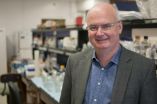(Press-News.org) The sun emitted a mid-level solar flare, peaking at 5:40 p.m. EST on Nov. 3, 2014. NASA's Solar Dynamics Observatory, which watches the sun constantly, captured an image of the event. Solar flares are powerful bursts of radiation. Harmful radiation from a flare cannot pass through Earth's atmosphere to physically affect humans on the ground, however -- when intense enough -- they can disturb the atmosphere in the layer where GPS and communications signals travel.
To see how this event may affect Earth, please visit NOAA's Space Weather Prediction Center at http://spaceweather.gov, the U.S. government's official source for space weather forecasts, alerts, watches and warnings.
This flare is classified as an M6.5 flare.
M-class flares are a tenth the size of the most intense flares, the X-class flares. The number provides more information about its strength. An M2 is twice as intense as an M1, an M3 is three times as intense, etc.
Updates will be provided as needed.
INFORMATION: END
NASA's SDO sees a mid-level solar flare: Nov. 3
2014-11-04
ELSE PRESS RELEASES FROM THIS DATE:
When less is more: Death in moderation boosts population density in nature
2014-11-04
In nature, the right amount of death at the right time might actually help boost a species' population density, according to new research that could help in understanding animal populations, pest control and managing fish and wildlife stocks.
In a paper in the journal Trends in Ecology and Evolution, a Princeton University researcher and European colleagues conclude that the kind of positive population effect an overall species experiences from a loss of individuals, or mortality, depends on the size and developmental stage of the creatures that die.
If many juveniles ...
Brain changes linked to prematurity may explain risk of neurodevelopmental disorders
2014-11-04
Disturbances in the early stages of brain growth, such as preterm birth – when many of the brain's structures have not yet fully developed – appears to affect the brain's neuro-circuitry, which may explain premature babies' higher risk of neurodevelopmental disorders including ADHD and autism spectrum disorder.
Researchers led by Natasha Lepore, PhD, of The Saban Research Institute of Children's Hospital Los Angeles, have located significant alterations to specific surface regions of the brain. Described in a study published online this week by the journal ...
High-speed 'label-free' imaging could reveal dangerous plaques
2014-11-04
WEST LAFAYETTE, Ind. – Researchers are close to commercializing a new type of medical imaging technology that could diagnose cardiovascular disease by measuring ultrasound signals from molecules exposed to a fast-pulsing laser.
The system takes precise three-dimensional images of plaques lining arteries and identifies deposits that are likely to rupture and cause heart attacks, said Ji-Xin Cheng (pronounced Jee-Shin), a professor in Purdue University's Weldon School of Biomedical Engineering and Department of Chemistry.
The imaging reveals the presence of carbon-hydrogen ...
Hot flushes are going unrecognized, leaving women vulnerable
2014-11-04
Hot flushes are one of the most distressing conditions faced by women who have been treated for breast cancer, but they are not being adequately addressed by healthcare professionals and some women consider giving up their post cancer medication to try and stop them, a new study has shown.
More than 70 per cent of women who have had breast cancer experience menopausal problems, and hot flushes in particular, which are among the most prevalent and potentially distressing problems following breast cancer treatment. These can also be long lasting, persisting for more than ...
How cells defend themselves against antibiotics and cytostatic agents
2014-11-04
This news release is available in German.
"On the one hand, ABC transporters causes diseases such as cystic fibrosis, while on the other hand they are responsible for the immune system recognising infected cells or cancer cells," explains Professor Robert Tampé from the Institute for Biochemistry at the Goethe University. The considerable medical, industrial and economic significance of ABC transporters is also based on the fact that they cause bacteria and other pathogens to become resistant to antibiotics. Likewise, they can help cancer cells to defend themselves ...
The inside story: How the brain and skull stay together
2014-11-04
CORAL GABLES, Fla. (November 4, 2014) — Think about the way our bodies are assembled during early development and ask: How do neighboring cells know that they are supposed to become a nerve or a bone cell and how do these tissues find the correct place and alignment? Researchers at the University of Miami (UM) are answering these crucial questions.
In a new study, UM researchers describe the signaling systems that tissues use to communicate with their surrounding neighbors, at the head-trunk region. Their discovery may have important implications for the treatment ...
Preventing postpartum hemorrhage
2014-11-04
Sublingual misoprostol is inferior to intramuscular oxytocin for the prevention of postpartum hemorrhage (PPH) in women undergoing uncomplicated birth at a regional hospital in Uganda, according to trial results published in PLOS Medicine. The randomized non-inferiority trial, conducted by Esther Cathyln Atukunda at the Mbarara University of Science and Technology, Uganda, and colleagues, showed that PPH incidence in the misoprostol arm exceeded that in the oxytocin arm by 11.2% (95% confidence interval 6.44%-16.1%).
PPH is responsible for 25–30% of maternal deaths. ...
Adenotonsillectomy and childhood asthma
2014-11-04
In an analysis of the 2003–2010 MarketScan US database, Rakesh Bhattacharjee and coauthors (University of Chicago, Chicago, Illinois) compared hospital admissions and prescriptions for children with asthma who underwent adenotonsillectomy before and after surgery to determine whether their asthma control improved (based on ICD-9-CM and CPT codes, as well as drug prescriptions) in the year after compared with the year before surgery. They also compared the children with children with asthma who did not undergo adenotonsillectomy who were the same age and sex and lived ...
Surgery for sleep apnea improves asthma control
2014-11-04
Surgical removal of the tonsils and adenoids in children suffering from sleep apnea is associated with decreased asthma severity, according to the first large study of the connection, published in the journal PLOS Medicine.
Researchers from the University of Chicago found that in the first year after the operation, children who had the surgery had a 30 percent reduction in acute asthma exacerbations and a 38 percent decrease in acute status asthmaticus—a medical emergency.
They also found pediatric patients who received the surgery had a 36 percent reduction ...
Genetic damage caused by asthma shows up in circulating blood stream, too
2014-11-04
Asthma may be more harmful than was previously thought, according to UCLA researchers who found that genetic damage is present in circulating, or peripheral, blood. Doctors previously thought that the genetic damage it caused was limited to the lungs.
In the study, researchers looked for the overexpression of a cytokine called interleukin 13 (IL-13), which is known to mediate inflammation, a critical problem for people with asthma.
The study, which was conducted in an animal model that mimicked human asthma, was the first to assess the role of IL-13 in genetic damage ...



